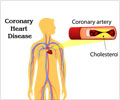By using eight clinical variables, scientists have found a new method, called the CRUSADE bleeding score, to estimate the risk of bleeding for a patient having a heart attack.
By using eight clinical variables, scientists have found a new method, called the CRUSADE bleeding score, to estimate the risk of bleeding for a patient having a heart attack.
The bleeding-risk assessment tool, created by scientists at Washington University School of Medicine in St. Louis, Duke University, could also help lessen the chances that heart attack patients will experience this common complication."Until now, there hasn't been a simple tool applicable to the general population that can predict the risk of bleeding before patients are treated for heart attack. Older methods for estimating risk either were derived from a low-bleeding-risk population or used variables that aren't available until after treatment is begun," said one of the study's authors, Richard G. Bach.
Medications and procedures intended to prevent ischemic complications, or damage caused by lack of oxygen to the heart- anticlotting drugs and catheter-based interventions to the heart - also increase the likelihood of bleeding, which can be deadly.
"The risk of bleeding is substantial in people with heart attacks. We found that this population could be risk-stratified, so that people at high risk of bleeding could receive less aggressive anticoagulant and antiplatelet therapy while those at low risk could receive full-dose therapy," says study co-author Brian F. Gage.
Led by Sumeet Subherwal, the researchers analysed the medical histories of more than 89,000 patients hospitalised in the US for non-ST-elevation heart attack.
This type of heart attack is the most common and usually results from a partial rather than complete blockage of the heart's arteries.
Advertisement
"A lot of treatment decisions have to be made very promptly after the patient arrives. So we designed a bleeding-risk stratification tool that would require only those variables that can be obtained up front. It's a practical tool that can be used in any hospital setting," said Bach.
Advertisement
The factors are gender, heart rate, blood pressure, hematocrit (the concentration of red cells in the blood), creatinine clearance (a measure of kidney function), diabetes, peripheral vascular disease or stroke, and congestive heart failure.
The bleeding score calculation assigns points to each factor so that the total score coincides with risk of bleeding evidenced in the CRUSADE cases.
The range of possible scores is divided into five categories from very low to very high risk of bleeding.
The aim behind the bleeding risk score is to help guide critical early treatment decisions for clinicians caring for heart attack patients.
However, Bach said that the impact of its use on outcomes would need to be tested in clinical trials.
Potentially, the score will be used in conjunction with other practice guidelines to optimize heart attack treatment and minimize risk.
The tool has been described in a study in the journal Circulation.
Source-ANI
LIN














